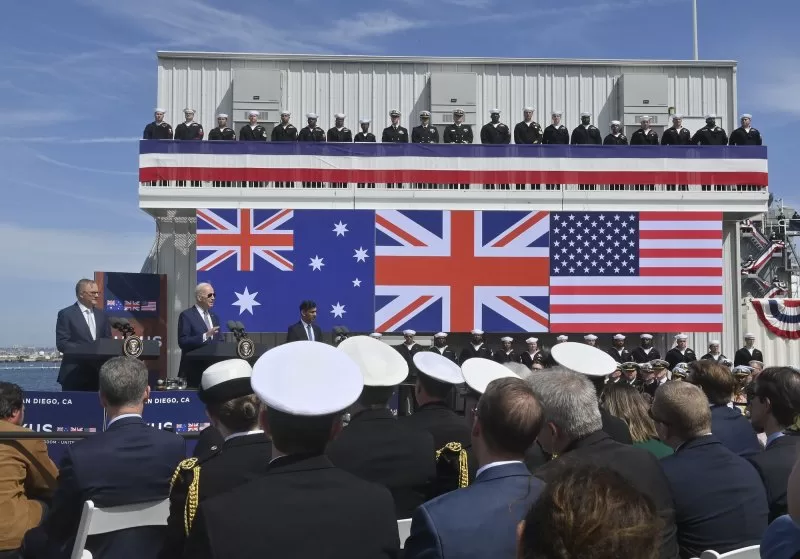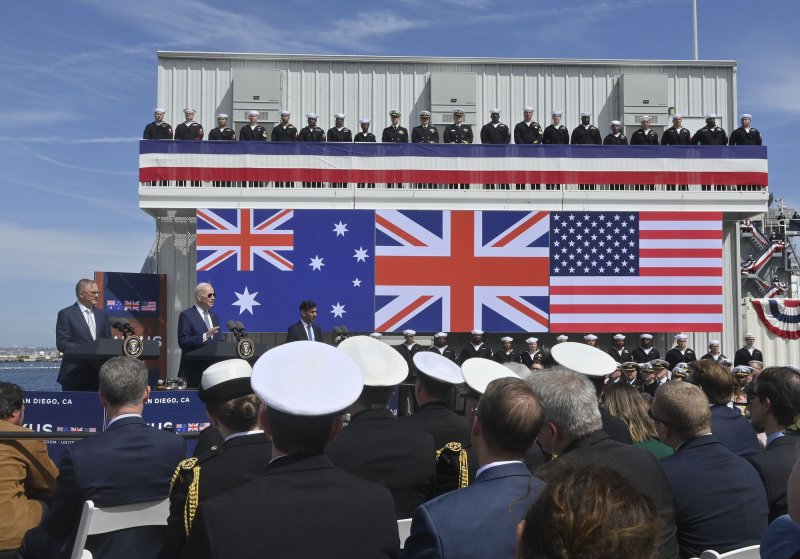President Joe Biden (C), then-British Prime Minister Rishi Sunak (L) and Australian Prime Minister Anthony Albanese discuss developments in their AUKUS military alliance at Naval Base Point Loma in San Diego, Calif., on March 13. 2023. On Monday, the three countries announced that they have entered an agreement under AUKUS to collaborate on the development of hypersonic weapons. File Photo by Jim Ruymen/UPI |
License PhotoNov. 19 (UPI) — The United States, Australia and Britain have signed an agreement under their AUKUS defense pact to jointly work on the development of hypersonic technologies.
In a statement on Monday, the three governments said they signed an agreement to enhance testing of hypersonic vehicles and accelerate the implementation of related technologies.
The Hypersonic Flight Test and Experimentation Project Agreement, under Pillar II of their AUKUS pact, specifically states that they may use one another’s testing facilities and share technical information concerning the development, testing and evaluating of hypersonic systems.
“We are increasing our collective ability to develop and deliver offensive and defensive hypersonic technologies through a robust series of trilateral tests and experiments that will accelerate the development of hypersonic concepts and critical enabling technologies,” Heidi Shyu, under secretary of Defense for Research and Engineering, said in a statement.
The three allies entered into the trilateral AUKUS pact in September 2021 to enable the countries to support one another’s security and defense interests, with Pillar I under the partnership being the commitment to aid Australia’s acquisition of nuclear-powered submarines.
Pillar II pertains to advanced capability development, including that of hypersonic weapons, which fly at speeds of at least Mach 5, meaning five times the speed of sound, making them difficult to counter.
The United States has been seen as trailing Russia and China in the development of hypersonic weapons, but growing concern about the two countries has spurred both Congress and Pentagon to prioritize building a hypsonic arsenal for the U.S. military.
For example, the Pentagon budget request for hypersonic research in 2025 was $6.9 billion, a jump from $4.7 billion in 2023.
According to Pentagon spokesman Maj. Pete Nguyen, ongoing hypersonic development efforts by the United States, Australia and Britain will be “woven together” through Monday’s agree, which includes up to six trilateral flight test campaigns to be conducted by 2028.
Britain’s ministry of defense said in a separate statement that this “landmark arrangement” will accelerate their development of hypersonic capabilities, including long-range strike missiles.
“By combining our expertise and resources with those of our closest allies, we are accelerating the development of crucial hypersonic capabilities,” Defense Secretary John Healey said.
“This work will keep us ahead of our adversaries on the battlefield, enhance our collective security and contribute to maintaining peace and stability in an increasingly complex and dangerous world.”

